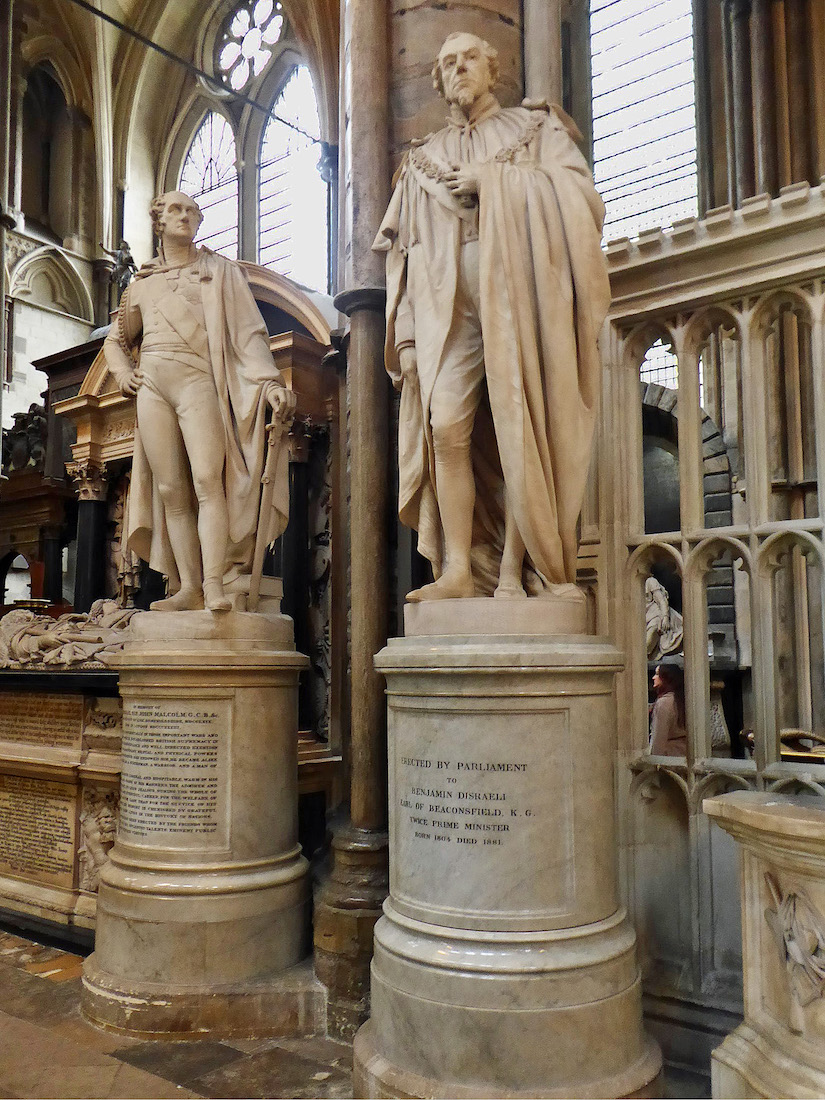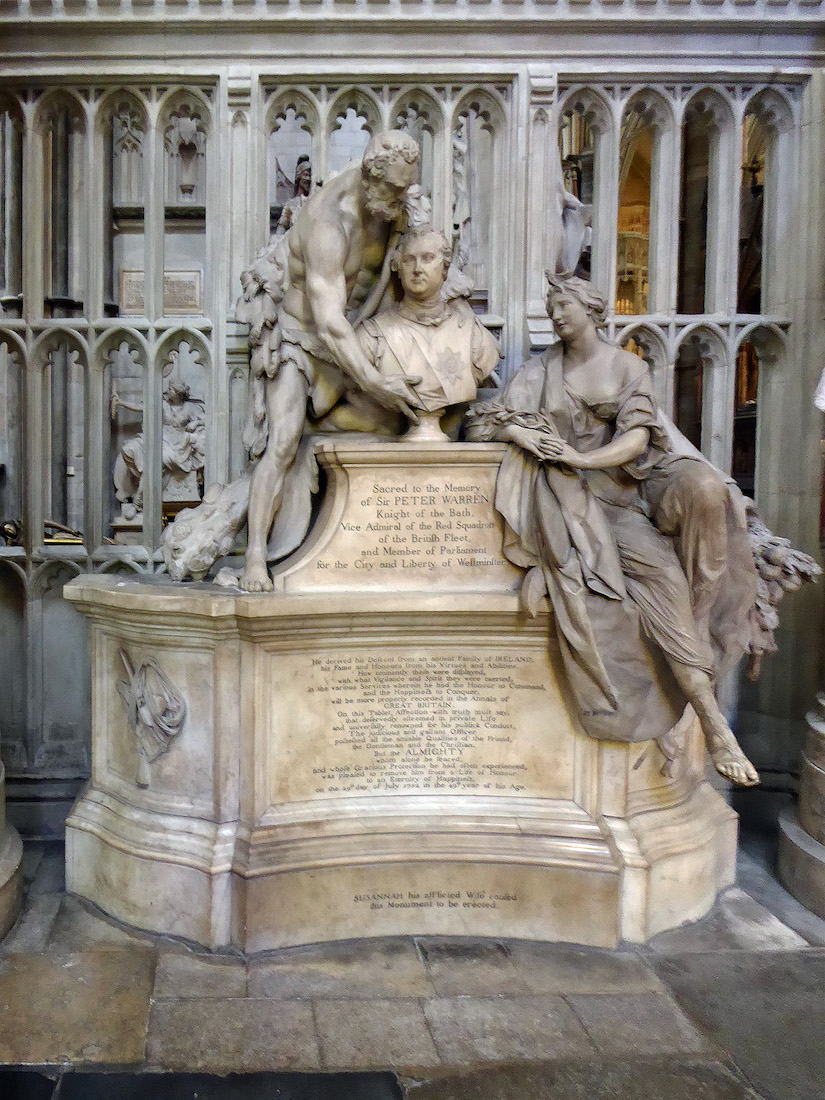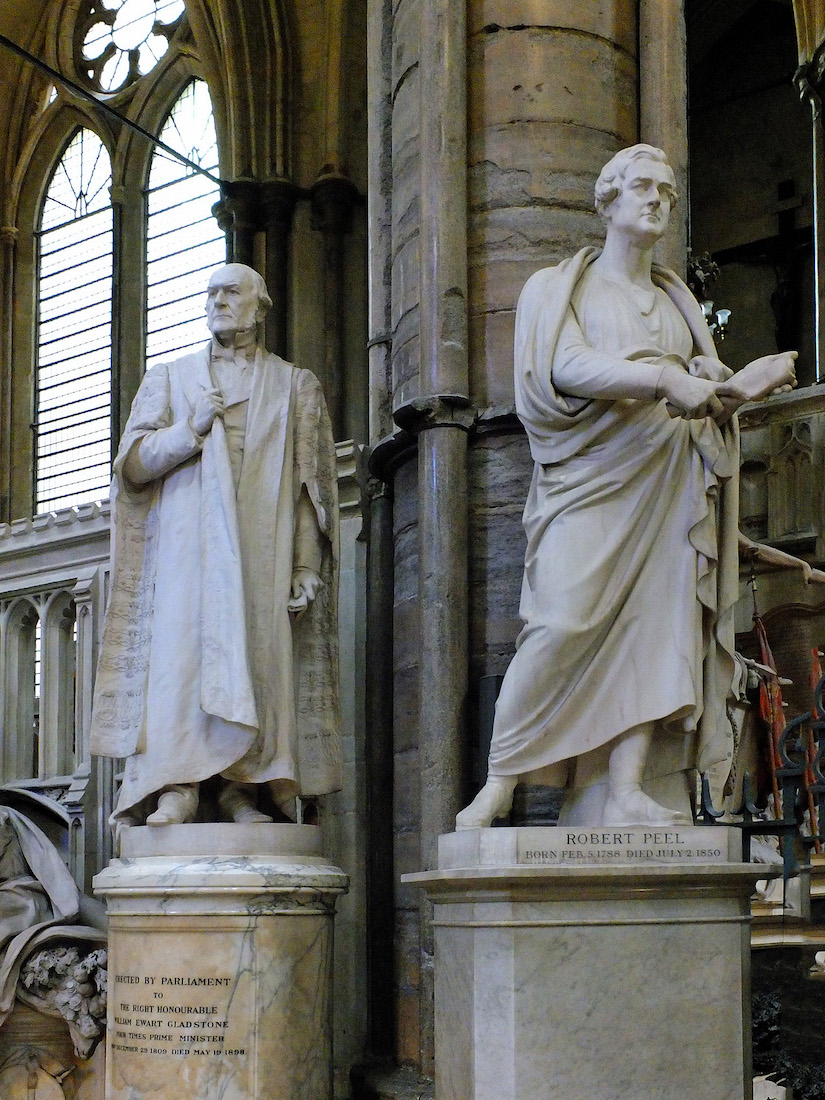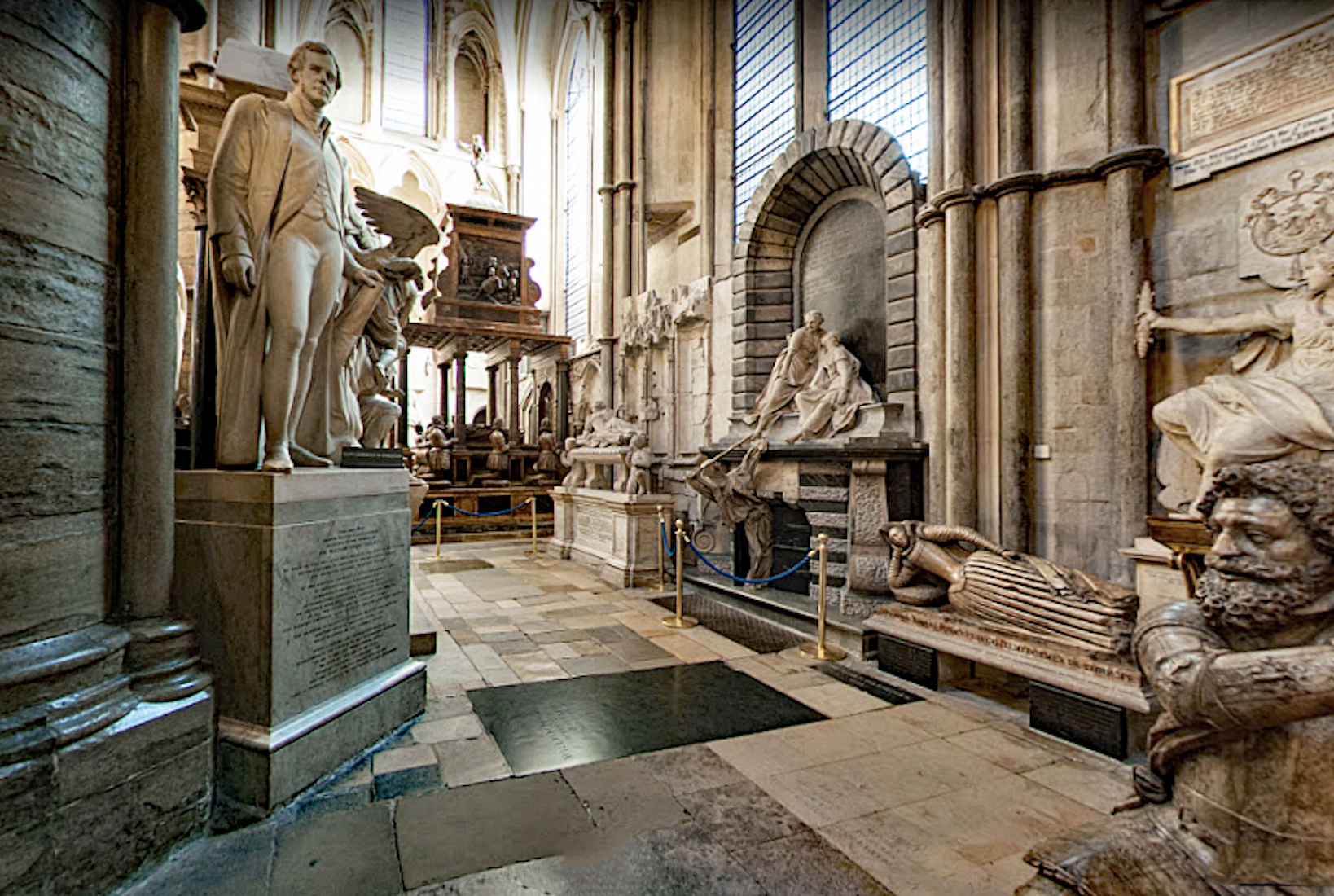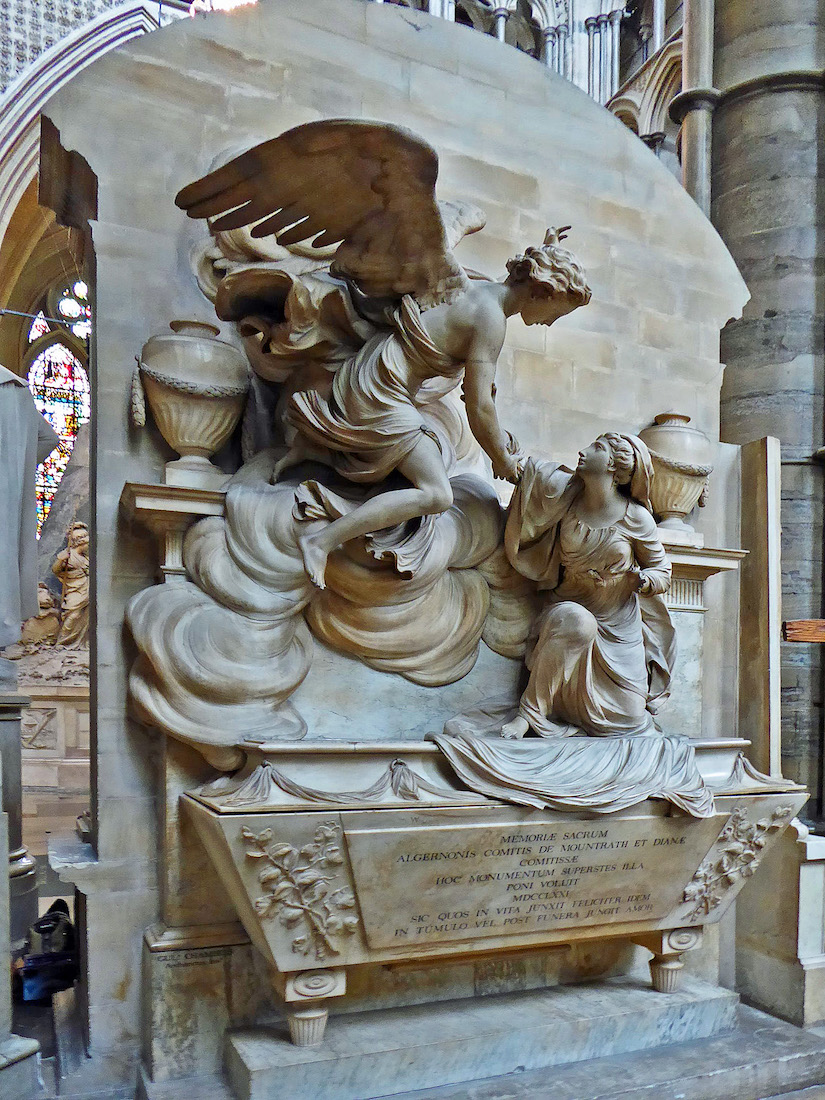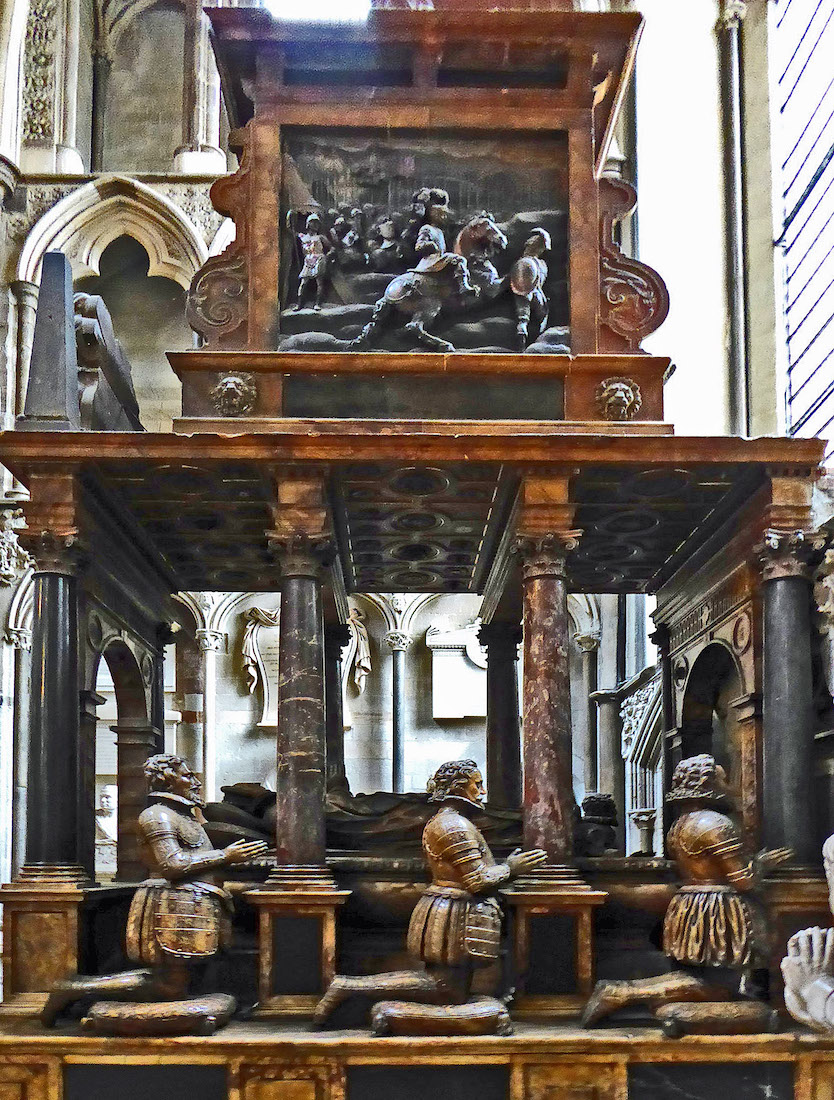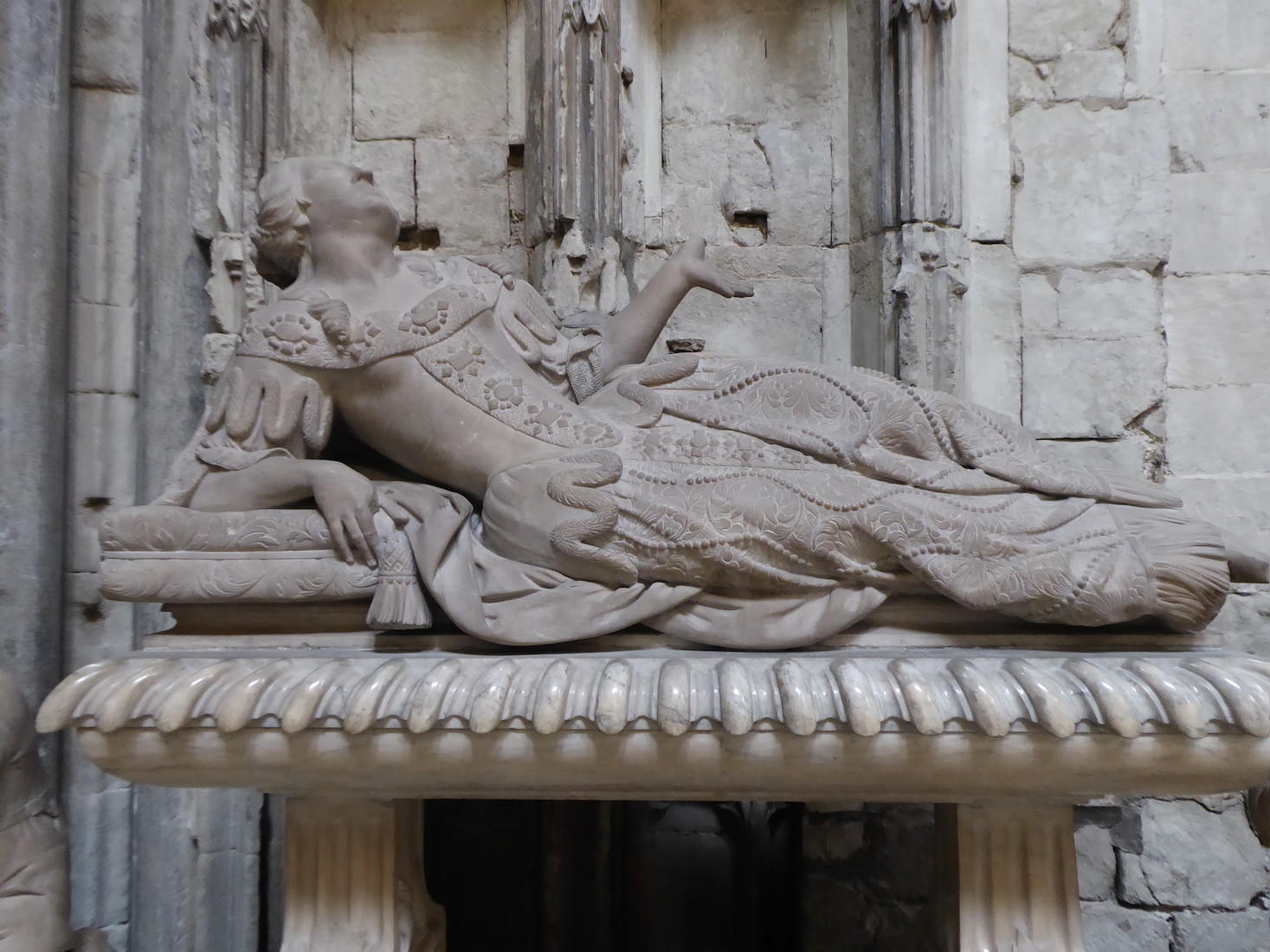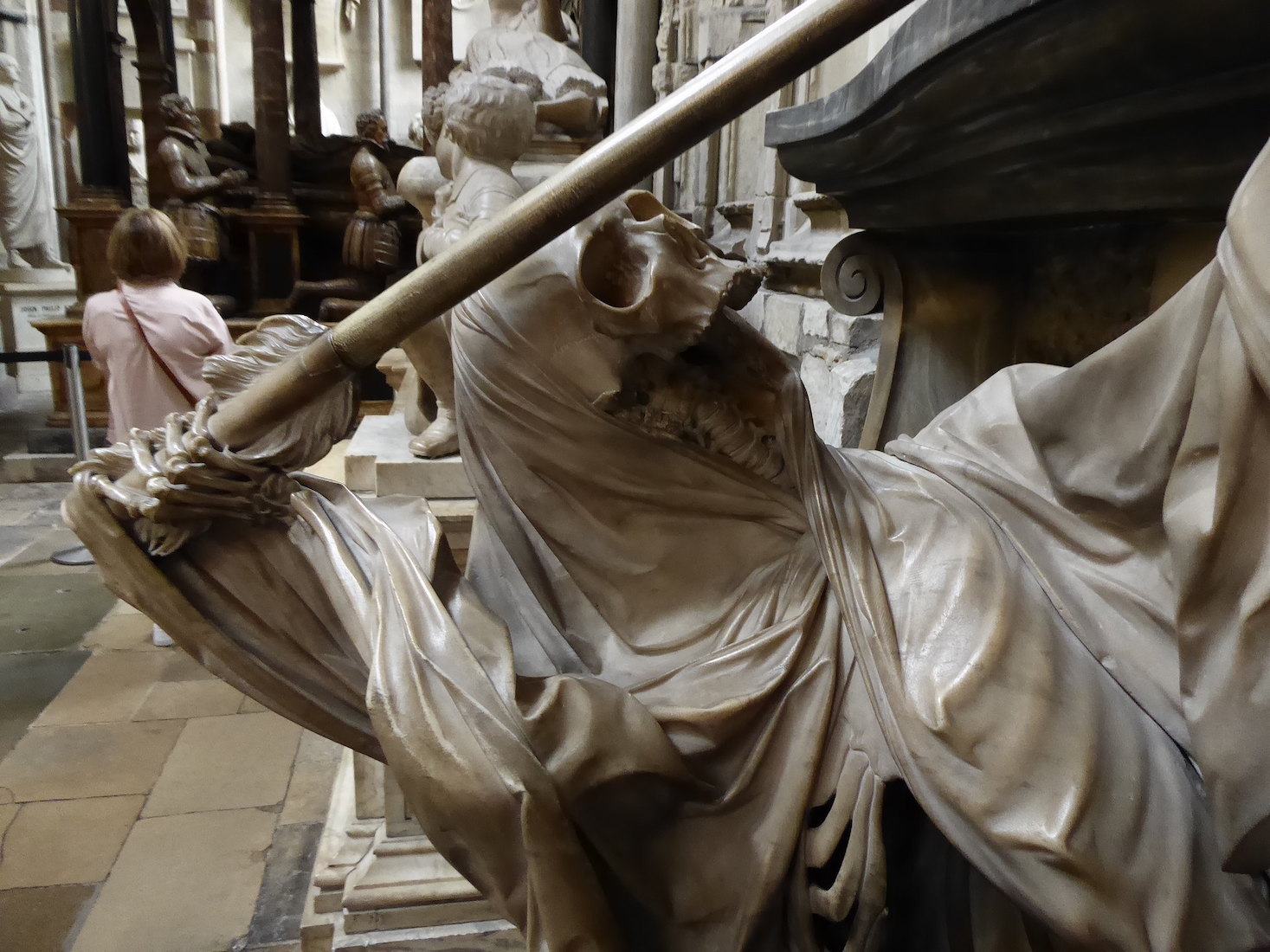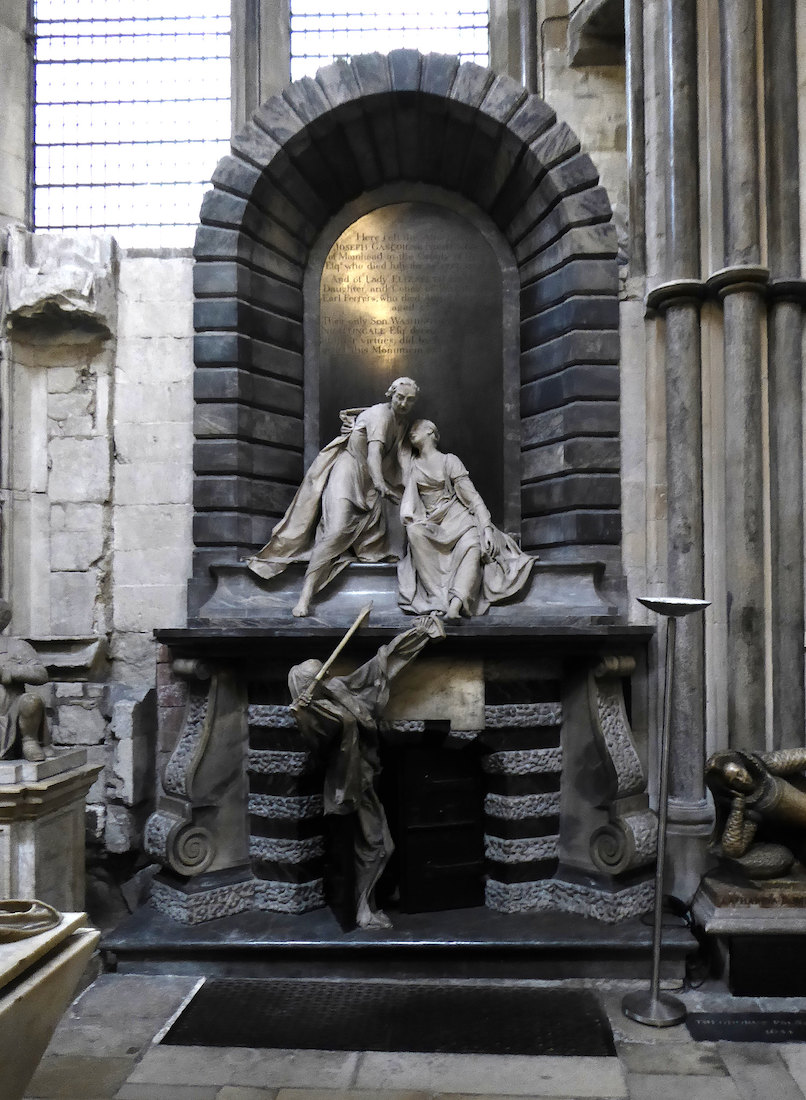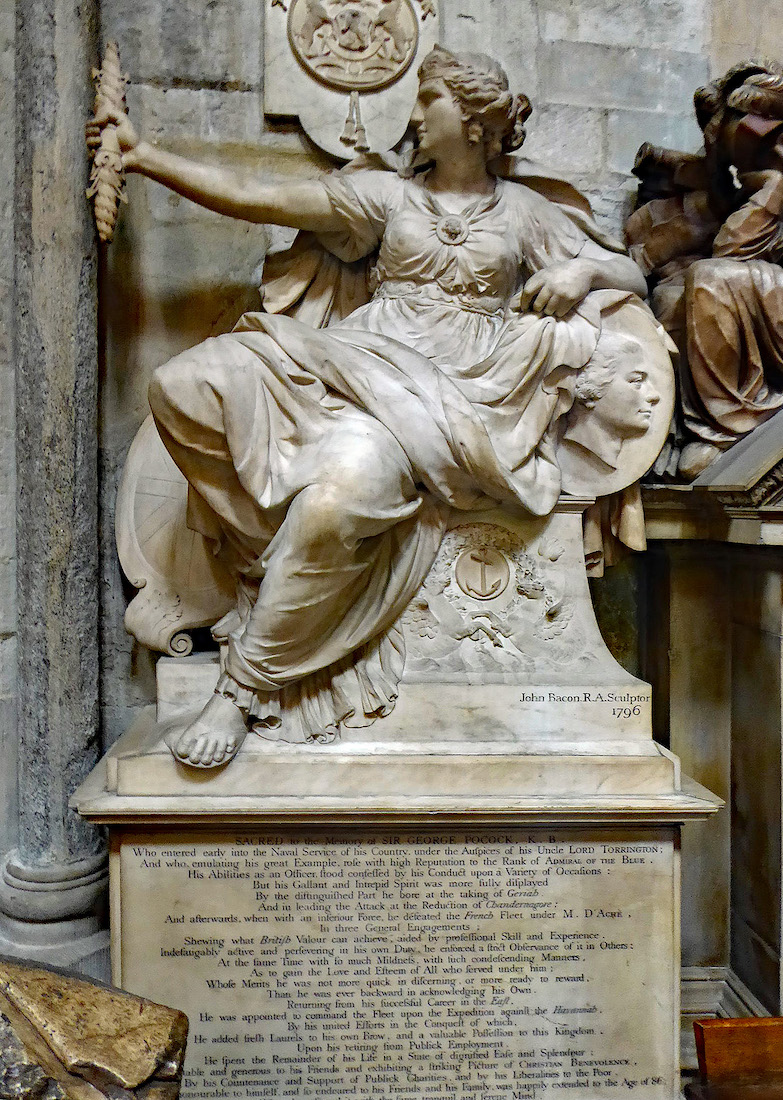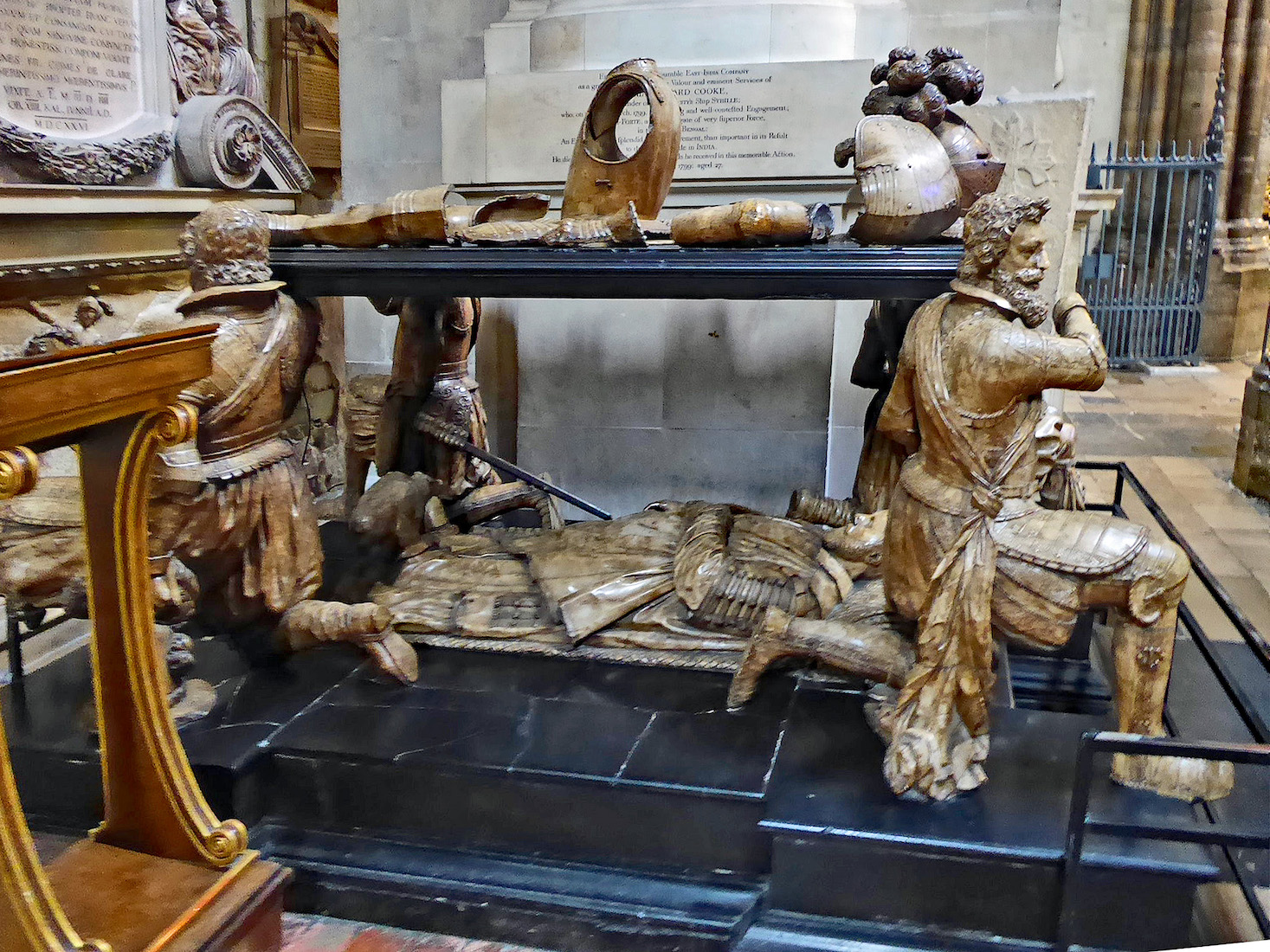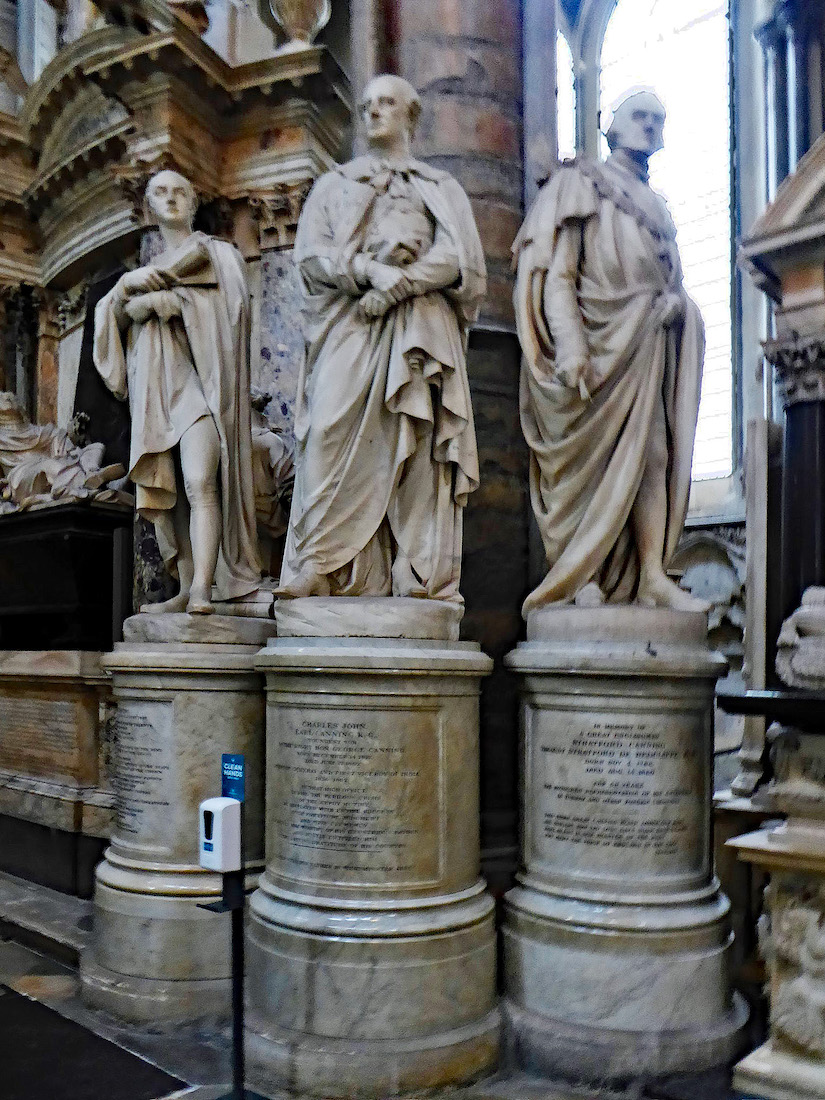
On this East side, three figures stand around the pillar between Bays 11 and 12. The figures are George, Charles and Stratford Canning (d. 1834, 1862 & 1880 respectively). George became Prime Minister in 1827. Charles served in Robert Peel’s government and became Governor General and first Viceroy of India. Stratford was created Viscount Stratford de Redcliffe and was made a Knight of the Garter. INDEX
D22. BAY 11, CAVENDISH MONUMENT AMT
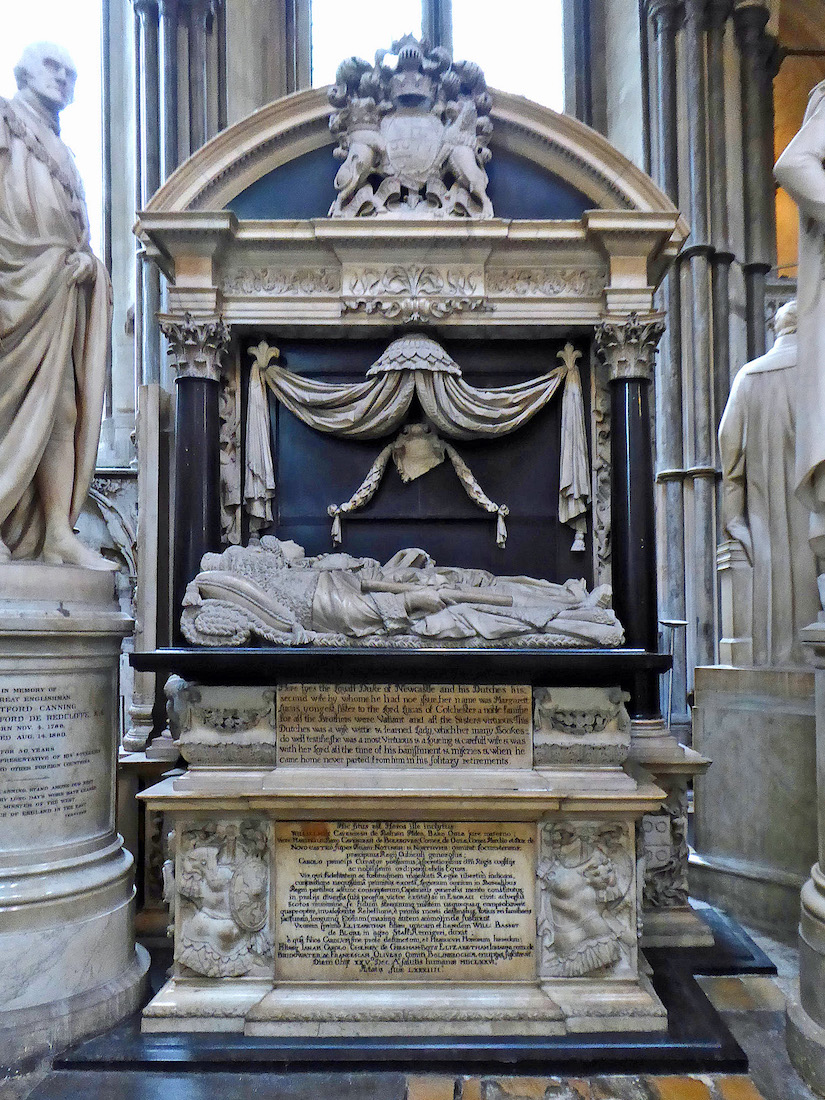
Next to the Canning figures is a monument to Wiliam Cavendish, Duke of Newcastle (d.1676) and his wife Margaret (d.1673). The monument is by Grinling Gibbons. The recumbent effigies show the Duke in his robes lying on a rush mattress wearing the chain of the Order of the Garter and holding a baton and the Duchess holding an open book, a pen-case and ink horn, in reference to her prolific literary output.
D23. MALCOLM AND DISRAELI MONUMENTS AMT
Following the Statesmen line, by the next pillar separating Bay11 and Bay 10, stand monuments to Sir John Malcolm (d. 1833), and former prime minister Benjamin Disraeli (d.1881). Malcolm was a soldier and statesman. The monument by Sir Francis Chantrey shows him in uniform with his left hand on a sword. The statue of Disraeli is by sculptor Sir J. Edgar Boehm and the statue was installed in 1884. The inscription reads: Erected by Parliament to Benjamin Disraeli Earl of Beaconsfield, K.G. twice Prime Minister. Born 1804. Died 1881.
D24. BAY 10, WARREN MONUMENT AMT
Next in this line is the Warren monument remembering Sir Peter Warren (d.1752). The monument is by Louis Francois Roubiliac. SirPeter Warren was naval commander at the taking of Louisburg and in 1747 was promoted Vice Admiral, also becoming a Member of Parliament for Westminster. His monument shows a figure of Hercules placing a bust of the Admiral on the pedestal, while a female figure of Navigation sits on one side.
D25. GLADSTONE AND PEEL MONUMENTS WA
We come to the South end of this line of political figures. At left is a white marble statue, on a pedestal, of William Ewart Gladstone by the sculptor Thomas Brock, erected in 1904. This was the last standing statue to be erected inside the Abbey. Due to lack of space it was decided that future memorials should be in the form of tablets, floor stones or windows. •• At right is a white marble statue of Sir Robert Peel, Prime Minister 1834-1835 and 1841-1846. The over life-size figure is by John Gibson. Peel is is best known today for the reorganisation of the London Police force. The early members of this force were called Peelers, after him.
D26. EAST AISLE GSV
We now move across to the East aisle of the transept. This aisle naturally has Bays 10, 11 and 12. These were originally designated as Chapels: respectively St John; SS Michael, Martn and All Saints; and St Andrew. But the way the various monuments are packed in makes the description of their placements a little complicated. In particular, public access is blocked to part of Bay 12 at the far end. The statue at left above stands at the base of the pillar between Bays 10 and 11; unfortunately I have been unable to identify him. Notice the wing extending out just beyond the statue!
D27. MOUNTRATH MONUMENT AMT
The wing belongs to the Mountrath monument: a memorial to Algernon Coote, Earl of Mountrath (d.1744) designed by William Chambers and carved by Joseph Wilton. (It has been erected on the rear side of the Cavendish tomb).
D28. BAY 12, NORRIS AND SOMERSET MONUMENTS AMT
Moving towards the end of this aisle we come to the Norris and Somerset monuments. It is not possible to go beyond the large Norris monument, although there are further memorials behind it.
D29. BAY 12, NORRIS MONUMENT AMT
This large monument remembers Henry Lord Norris (d.1601) and his wife Margaret. This towering monument was sculpted by Isaac James and features the couple’s sons kneeling around the central tomb-chest and effigies, though despite all the ostentation the couple were not actually buried here.
D30. SARAH SOMERSET MONUMENT AMT
Along the wall to the right of the Norris monument is this memorial to Sarah, Duchess of Somerset (d.1692. This was originally part of a much larger monument (perhaps by Grinling Gibbons) that was reduced in size in the 19th century. She has an excellent epitaph (in Latin): Here lies the late most illustrious Duchess of Somerset, ever celebrated for her charity and beneficence, who erected a grammar school for boys at Tottenham in the county of Middlesex, enlarged the income of the Green Coat Hospital at Westminster, largely endowed Brasenose College in Oxford, and St John's in Cambridge, for the education and nourishing of youth in piety and good literature; she was likewise an encourager of trades and handicrafts, and had a tender regard to old age, by erecting an almshouse at Froxfield in Wiltshire for thirty widows: she was very charitable to the poor of St Margaret’s Westminster, where she instituted a lecture, and gave many stately ornaments to the Church. She died the 25th of October 1692.
D31. NIGHTINGALE MONUMENT AMT
Of all the monuments in the Abbey none is more dramatic than that of Lady Elizabeth Nightingale (d.1731). This unforgettable monument (not erected till 1761) is situated in the east aisle of the north transept and is a remarkable piece of sculptural theatre by Louis Francois Roubiliac and depicts the stricken Lady Nightingale in the arms of her husband who is recoiling in terror from the grisly figure of Death as a shrouded skeleton emerging from a sepulchral door below to attack with his spear. A true masterpiece of art and horror!
D32. BAY 10, LADY CATHERINE EFFIGY AMT
Next along this wall is this effigy of Catherine, Lady St John of Bletso (d.1615). The effigy is the only remaining part of a larger monument.
D33. BAY 10, POCOCK MONUMENT AMT
Next is the monument to Sir George Pocock (d.1792) by John Bacon. It shows a seated figure of Britannia, her right hand holding a thunderbolt and her left resting on a portrait relief of the Admiral. On the left is a shield with the crosses of St George and St Andrew. The pedestal is decorated with sea-horses and other naval emblems. The inscription reads (in part): Sacred to the memory of SIR GEORGE POCOCK, K.B. [Knight of the Order of the Bath], who entered early into the naval service of his country, under the auspices of his uncle LORD TORRINGTON; and who, emulating his great example, rose with high reputation to the rank of ADMIRAL OF THE BLUE.
D34. BAY 10, HOLLES MONUMENT AMT
Crammed against the Pocock Monument is the Holles monument – a memorial to George Holles (d.1626) by Nicholas Stone. From the Latin inscription we learn: Francis Holles, a brave youth, who returning from making a campaign in the Netherlands, died 12 August in the year of our Lord's age 1622 and of his own the 18th; his afflicted father, John Earl of Clare, to this his valued, and lamented son, erected this monument.
D35. BAY 10, VERE MONUMENT AMT
The last monument to see in this East aisle is this tomb of Sir Francis Vere (d.1609). One of the most remarkable monuments in the abbey, the deceased is shown as an effigy lying beneath a marble slab displaying elements of his armour borne upon the shoulders of four kneeling knights, all executed in a mixture of alabaster and black marble. ••• This completes our investigation of the North transept. We shall now walk over the crossing to the South transept.


